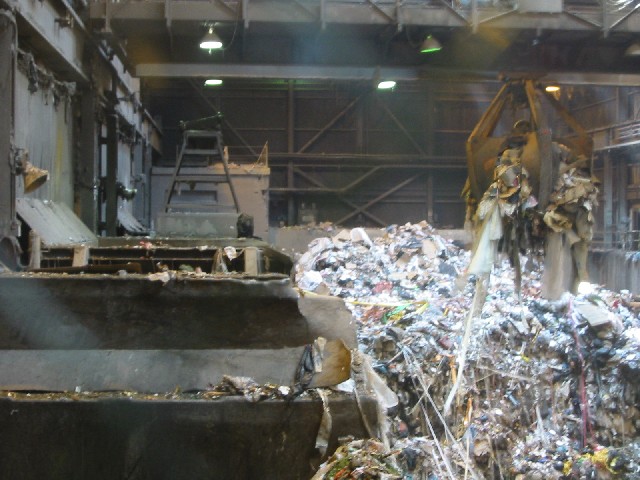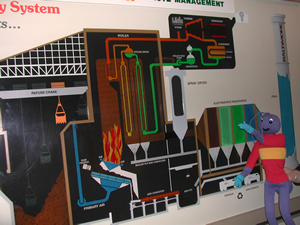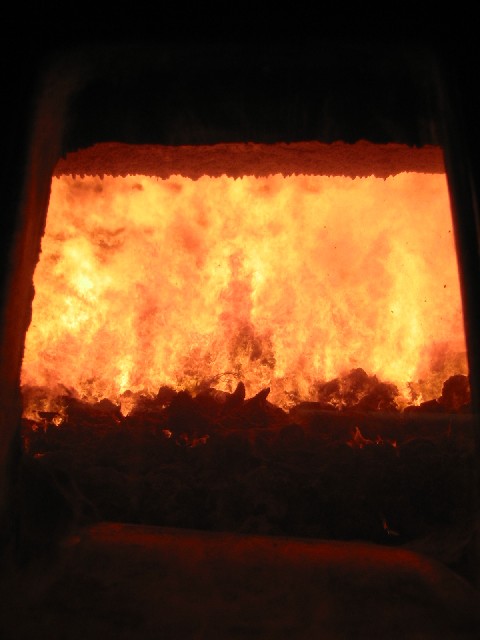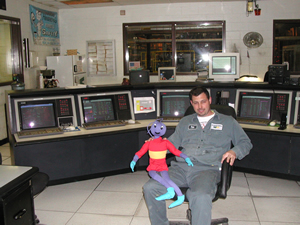A Report from Energy Ant — My Trip to the RESCO Trash-to-Energy Plant in Baltimore, Maryland

Today I got the chance to visit a very unusual energy site in Baltimore, Maryland where they turn trash into energy! The Refuse Energy Systems Company (RESCO) plant burns municipal solid waste, a fancy name for household trash, to heat boilers which produce steam. The steam is used to provide heating and air conditioning, and to turn a turbine to produce electricity. There are 16 plants like this one in the U.S. This plant was opened in the fall of 1984 and services the needs of the city of Baltimore, Baltimore County, and the surrounding county of Anne Arundel. It has processed more than 9 million tons of waste so far, and can provide electricity for as many as 40,000 homes. The steam from the plant satisfies the heating needs of the city of Baltimore and a large portion of its cooling needs.
The Process of Recycling Trash Into Energy…


Garbage trucks enter the plant to dump their refuse(trash) into a "receiving pit". (No fuels, tires, sludge or trash from the hospital are allowed.) From this area, a crane with a huge mechanical claw scoops up three or four tons of garbage at a time and dumps it into the feed hopper or "intake" of one of three processing units. These hoppers are fed by gravity. At the bottom of the hopper, "ram feed stokers" push the trash into a fire that burns at 2,500 degrees Fahrenheit. This burns the trash as it is received—the trash is NOT separated —just dumped in "as is." The glass and aluminum melt. At about 750 tons a day per intake or feed hopper, with all three intake or feed hoppers operating, the plant can burn about 2,250 tons of trash a day total. See a flowchart!
Inside each unit is a slanted metal grate that vibrates back and forth. It slowly transports the refuse through the fire and allows for complete combustion (or burning) to occur. It takes about one hour for any single piece of garbage to pass all the way through the furnace.The RESCO processing system successfully reduces the volume of incoming garbage by 90% (the big pile of trash that goes in turns into a small pile after it is burned). The remaining 10% consists of ash, ferrous (made of or contains some iron) and non-ferrous metals.
After the garbage is completely processed, the ferrous and non-ferrous metals are separated from the residue (the rest that is left over). The facility has successfully removed over 150 million pounds of metal and recycled it into the scrap metal market since 1984. This would be enough metal to build 5 Titanics!! The ash is treated and sold to various landfill sites which use the ash as a "cover" to seal either the whole site or to separate different layers within a landfill. This ash becomes very hard and solid after being wet down with some water.


All fires need air to burn. In this plant, the primary source for combustion air is drawn from the receiving pit area. This causes a sustaining negative air pressure in the receiving pit – the air pressure is actually lower in the receiving pit than it is outside of the plant. This negative pressure prevents any "garbage" odors or dust from escaping into the outside environment. Even though they deal with tons of garbage, it isn't really that stinky outside the plant.
This plant doesn't just burn the trash, it also uses it to help produce other "products." Surrounding the grate systems are large utility-type power boilers which are designed to recover and "recycle" the thermal energy released by the garbage during burning. This recycled energy is recovered in the form of high pressure steam.
Everything that goes on in the plant is monitored in the control room. At full capacity,(the largest amount that can be processed at one time) the plant can generate more than 500,000 pounds per hour of steam. The energy from the steam is used in the form of steam itself or electricity. BRESCO can supply up to 300,000 pounds per hour to Trigen Baltimore for direct steam heating or summer cooling (using chillers) in downtown Baltimore.
The facility is also capable of generating 60,000 kilowatts of electrical energy for Baltimore Gas & Electric Company using its turbine generator to convert the steam into electrical energy.
The energy recaptured by the plant can provide electricity for as many as 40,000 homes. The plant’s production is sufficient to satisfy downtown Baltimore’s heating needs and a significant portion of its air conditioning needs.


